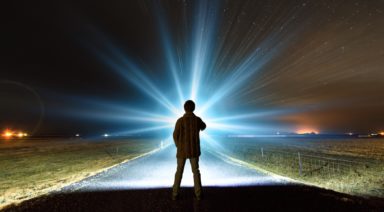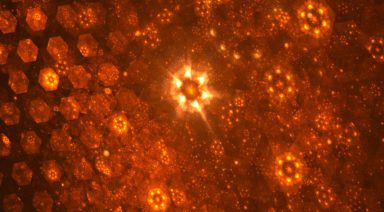NASA May Have Found Evidence of an Advanced Alien Civilization in the Cygnus Star System

KIC 8462852
Also known as Tabby’s star, has shown inexplicable fluctuations in its brightness, potentially suggesting the presence of an advanced civilization.
There’s one star that many astronomers, both amateur and professional, are focusing on right now, known as KIC 8462852, or Tabby’s star. The odd nature of this star has led some to believe that it could possibly be a sign of highly intelligent alien life in the Cygnus star system, some 1,280 light years from us. What’s so intriguing about Tabby’s star is that it has been dimming drastically over time and in dramatic fluctuations.
These fluctuations have confounded scientists who have trained a multitude of high-powered telescopes on it, including NASA’s Kepler telescope that originally discovered it. The massive dips that have been recorded in its luminosity have led some to speculate that it could be an advanced alien civilization building a Dyson sphere or swarm around the star, harvesting its energy in a process referred to as star lifting.
Tabby’s star was first discovered by an astronomer at LSU, named Tabatha Boyajian. She is now the head of the Planet Hunters project, a program that searches for exoplanets in other solar systems, especially those that could potentially harbor life. She said that initially the program would have been deemed a success if they found just one exoplanet that fell in the habitable zone, but it has since found more than 50. But the program has received the most attention due to its recent observations of KIC 8462852, which has been exhibiting a phenomenon that scientists can’t fully explain.
What’s so strange about Tabby’s Star is that astronomers have recorded drastic dips in its brightness by up to 20 percent. To put it into perspective, usually a planet orbiting a star will only generate a one percent decrease in light. And while a decrease in brightness of this magnitude is common in young stars, due to their protoplanetary disks, Tabby’s star is not young and a disk has been ruled out from infrared imaging.
Numerous theories have been proposed to define the anomalies in the data associated with Tabby’s star, but none have succeeded in fully explaining what’s going on. Even Tabby, herself, hasn’t ruled out the possibility that it could be an alien civilization. She’s even asked some friends at SETI (Search for Extraterrestrial Intelligence) to aim a radio telescope on the planet to see if they can pick up any signals being transmitted form the area.

Kepler Data for Tabby’s Star
The Dyson sphere, in its different variations, is a concept first theorized in science fiction and made popular by Freeman Dyson. It fulfills a specific criterion on the Kardshev Scale, a hypothetical measure for the level of technological advancement of a civilization. Once a civilization reaches the point that it can harness all of the energy on its planet and others in its solar system, it would supposedly move on to build a sphere around its star, in order to meet its energy needs.
Scientists believe that whatever is orbiting Tabby’s star is within the habitable zone. And while some skeptics say that the strange results are simply incorrect data or bands of asteroids orbiting the star, many of these assertions have been disproven and no theory has sufficiently explained what’s going on.
Another bizarre variable that is evident in the observations is that the light coming from the star is blocked in an asymmetrical manner. If it were a planet or other orbiting body, one would expect to see symmetry. The star also appears to show an overall dimming over time, since observations began in the early 1900s. On average, the star has been dimming by 16 percent every 100 years. This is a highly unusual rate to see a star’s luminosity diminish. This could allow for two assumptions regarding the alien hypothesis. Either they are slowly extracting energy from the star, or they are slowly building solar panels around the star, blocking more of the light that we are able to see.
One might argue that this civilization would have to be moving very quickly to build its Dyson sphere, as Tabby’s star is 1.6 times the size of our sun. Also, one would expect to see an expulsion of waste, likely in the form of radiation, if they were harvesting directly from the star. But one user in the Reddit forum that is dedicated specifically to the star, brought up science fiction novelist, Arthur C. Clarke’s, third law regarding advanced civilizations; any sufficiently advanced technology would be indistinguishable from magic. Essentially, a civilization’s technology, that is advanced to the point of harvesting energy from a star, would be incomprehensible to us.

A Dyson Swarm or Dyson Sphere
Now that our attention is piqued and we have a number of eyes and ears trained on Tabby’s star maybe we’ll be able to discover what’s really going on in the Cygnus constellation. Is it simply a natural phenomenon that will lead us to new discoveries or groundbreaking evidence of a hyper-advanced civilization? Hopefully we will soon learn more.
Randy Cramer: Soldier of The Mars Defense Force

Randy Cramer’s life experiences are either incredible or absurd. He reports that he spent 20 years as a Marine in the U.S. Secret Space Program (SSP). His tour of duty took him first to an elaborate, secret, fully-equipped base on the moon. Then, he went to Mars where he spent 17 years at a military base. After a major loss of human lives during a battle between the military forces and native people of Mars, he was deployed back to the moon where he spent his final three years as a military pilot. He tells his story with vivid and captivating detail.
Randy Cramer: Space Traveler and Mars Colonist
Randy Cramer, who initially told his story under the pseudonym “Captain Kaye,” says he was only four years old when he began training for the SSP through a program called Project Moon Shadow. He was one of approximately 300 girls and boys who were “covertly drafted” to participate in the program. Girls comprised only 20 percent of the group, a male/female ratio that remained consistent during his entire 20 years with the SSP.
Cramer recalls that during his childhood, he would be taken from his bed at night. Even though he would be gone for days or even weeks, he would be returned to his bed and travel back in time to when he was taken. He would wake up as though no time had passed, feeling like he had just had a really, really long dream.
When he turned 17 in 1987, Cramer was involuntarily recruited to be part of the Mars Defense Force (MDF), whose purpose was to protect five civilian settlements already in existence on Mars.




































